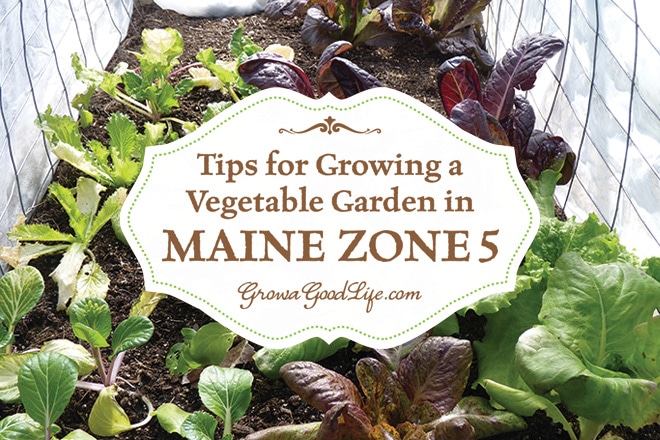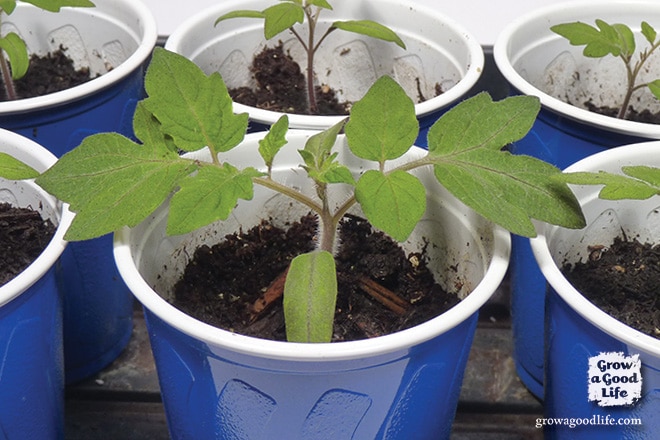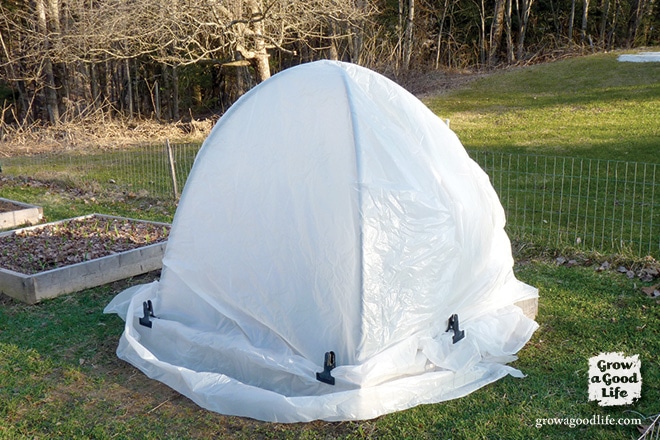Vegetable Gardening Tips for Maine Zone 5
This post may contain affiliate links, which means that I may receive a commission if you make a purchase using these links. As an Amazon Associate I earn from qualifying purchases.
Each gardening location has unique environmental factors that affect the growing season. Even when faced with a short growing season, a lot can be harvested with some experimentation and careful planning. These vegetable gardening tips will challenge you to grow an abundance of food in colder climates.

The most common methods to determining your growing zone in the US and Canada are the USDA Plant Hardiness Zone Map and Canada’s Plant Hardiness Maps. These maps divide regions based on average minimum temperatures. You will find Plant Hardiness Zone Maps referenced in all the gardening books and on the back of seed packages. Grow a Good Life is located in Maine, Zone 5b: -15˚F to -10˚F.
Although the Plant Hardiness Zone Maps are a great reference to estimate the minimum temperature a plant can survive, this is only part of what affects your growing season.
Zone 5 stretches from Maine to Missouri to Utah and even to Colorado. However, the local climates among these locations are all different. Each location has unique environmental factors that also affect the growing season. These factors include soil, number of frost-free days, rainfall amounts, summer heat levels, soil moisture, humidity, and day length.
Environmental Factors that Affect the Growing Season in Maine, Zone 5:
- Soil: The soil pH in Maine tends to be acidic, which can affect the nutrients that are available to your plants. It is helpful to have a soil test done to determine if your soil benefits from specific amendments to neutralize pH and add nutrients. Soil tests are available at your local extension office.
- Frost-free Days: Our summer growing season is short with frost-free days ranging from mid-May to mid-September.
- Rainfall Amounts: Maine experiences frequent rain throughout the growing season. We often have stretches of several weeks at a time without rain where supplemental watering is required to keep the garden growing. However, no dry period as experienced in other locations around the country.
- Summer Heat Levels: Our summers are warm with an average temperature of around 75˚F for the months of May, June, and July (Source: usclimatedata.com). We do experience periods of hot weather spikes from time to time.
- Humidity: Humidity levels are high in July and August. Morning dew lingers on plants making them susceptible to mold and fungus diseases.
- Day Length: Day length peaks at 15:26:43 on the June 21st Summer Solstice and declines to 11:47:12 by September 30th (Source: timeanddate.com).
Gardening Tips for Maine Zone 5:
1. Plan the Growing Season:
The gardening season begins indoors in January or February with planning by sorting seeds and Making a Seed List, Mapping the Garden Beds, assembling a Seed Starting Shelf, and developing a Seed Starting Schedule.

2. Extend the Growing Season:
We challenge our short growing season and extend it by starting seeds early inside under lights and transplanting them to the garden when the danger of frost has passed or under protection. The first seeds sown are Onions with Celery soon to follow. We also rely heavily on hardy crops such as cole crops, kale, spinach, lettuce, and other resilient greens that can withstand cool temperatures and light frosts of early spring.
Most seasons we are unable to work in the garden until March, especially if the beds are under a heavy blanket of snow. Once the snow finally recedes, it takes time for the soil to be workable. Most of the garden has been converted to raised beds because these drain and warm up quicker giving us a head start on transplanting spring greens under protection.

3. Don’t Be Tempted to Plant Too Soon:
Memorial Day Weekend is the traditional time to put the garden in my area. This is when we transplant our cold sensitive plants, such as tomatoes, peppers, eggplant, and basil into the garden. Although warm spring days may entice me to transplant earlier, the cool nights and soil temperatures are not beneficial to growth and may even stunt the plants. I learned my lesson a few times and now wait until it is hot enough for the plants to thrive. See: How to Harden Off Seedlings.
4. Keep the Garden Producing:
Summers are humid, warm and with frequent rain. The garden begins to thrive by July. Succession planting keeps the garden beds producing. When the spring greens are finished, the beds are planted with fast maturing crops, such as bush beans. Most often we won’t see a ripe tomato until August but when they begin, there is an influx that keeps the counters full and the canner rocking. See: 13 Quick Growing Vegetables for Your Fall Garden and 3 Succession Planting Tips to Maximize Your Harvest.

5. Start the Fall Garden Early:
Just when the garden is finally beginning to flourish, it is time to plant the fall garden. Seeds are sown for cool season plants that can tolerate light frosts, thrive in short daylight hours, and grow in the cooler temperatures of fall. I usually start fall crops inside in the cool basement under lights in July to be transplanted into the garden as the summer heat fades and gardening space opens up. Again, we rely a lot on kale, spinach, lettuce, and other resilient greens to continue to provide fresh harvests well into fall and even winter with some additional protection. See 13 Quick Growing Vegetables for your Fall Garden.
6. Clean Up the Garden at the End of the Season:
Our first frost usually arrives sometime in October and while this is the end of the season for some crops, the cold hardy greens carry on providing us with harvests well into November. Garlic is planted and mulched before the ground freezes. One by one the garden beds are cleaned up and layered with compost and mulch for the winter. Taking the extra effort to clean up the garden beds in the fall makes it very easy to begin growing the following spring. Finally, the garden is allowed to rest until the next year begins. See: 7 Tips to Prepare Your Vegetable Garden for Winter.
Overcoming the Gardening Challenges in Your Area
The best way to learn about your growing area is to ask others who garden nearby. Gardeners are generous by nature and enjoy sharing their experiences and tips on gardening successfully. Talk with your neighbors or even someone you meet in the seed aisle at your local garden center. Ask them the varieties of plants they like to grow and what they suggest to make the most of the growing season. Be prepared for a long conversation because once you begin swapping stories it can be both entertaining and enlightening.
Even when faced with a short growing season, a lot can be harvested with some experimentation and careful planning. I continue to strive to make the most of our gardening season by discovering creative ways to extend the season, select crops with a short maturity date, and try to keep the beds producing by succession planting. I keep careful notes and compare growing seasons from year to year and make adjustments as needed.
[sc:gglnews ]

Great article, just what I was looking for. Wanted to start a few vegies with the kids, we dont have much room and ive in Ma on the North Shore. Can you reccomend anything that doesnt require much space that produces on the early side? Thanks for the tips !
Matt, Radish comes to mind. The seeds are easy to handle and it matures quickly. Asian greens such as Tatsoi and Bok Choy also grow fast. Another fun project for kids is making homemade seed mats for lettuce and carrots: https://growagoodlife.com/homemade-seed-mats/.
Awesome post and so helpful! Thanks for sharing with us at Savoring Saturdays!
Great tips, with all the ice storms we are having down here in Maryland, this is a great resource. Thanks for linking up to Awesome Life Friday!
Thanks for sharing at the Homestead Blog Hop! Hope to see you again this week. 🙂
With the record breaking cold temperatures we’ve been having, today I was dreaming about getting back to my garden hopefully soon. Hence your link caught my eye at Savoring Saturdays. This is a very nice post. Ah, I’ll have to heed #3 and not be tempted to plant too soon. 🙂 The owner of my local nursery always says, “A green thumb is a thumb of knowledge and experience.”
Can’t wait for Spring.
With so much snow on the ground here, I cannot believe sowing and planting season will soon be here. I live in zone 6b, so I am glad you included a list of bloggers who are also in the same area. Love your tips for environmental factors that affect Growing season! Thanks for sharing on Merry Monday.
Thank you so much for sharing your helpful and enlightening gardening tips with us at the Healthy, Happy, Green and Natural Party Blog Hop. I’m pinning and sharing!